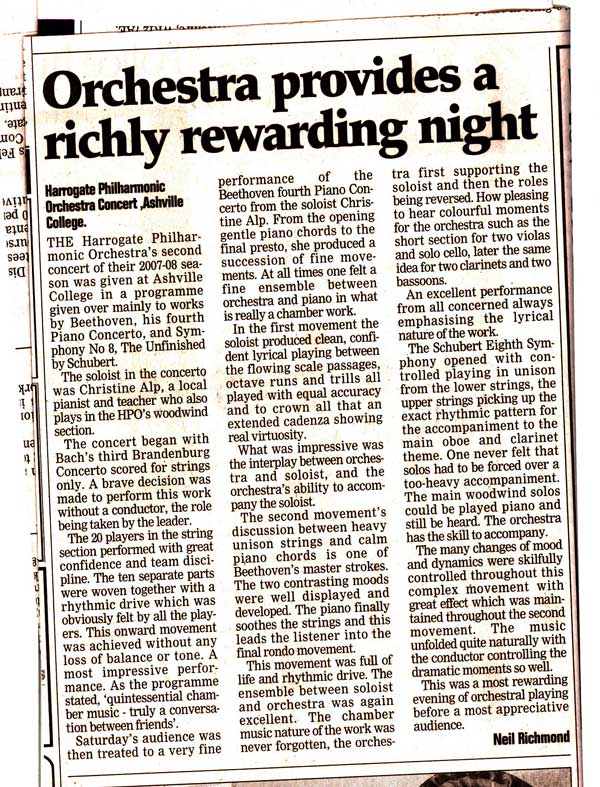
Harrogate Philharmonic Orchestra
Conductors - Jeremy Carnall
& Yannis Daoutis
Leader -
Reviews of Harrogate Philharmonic Orchestra's concerts
15th February 2023
Easingwold Parish Church
Harrogate Philharmonic comes to Easingwold
An audience of around 100 were treated on Sunday afternoon to a spell-binding concert in Easingwold Parish Church, given by Harrogate Philharmonic Orchestra under the baton of Jeremy Carnall and leadership of Chloe Fletcher. Jeremy's considerable skill as conductor was much in evidence in enabling the musicians to give of their best.
The stars of the show were Violinist Rachel Smith, who also sang the soprano solos most beautifully, and the brilliant young Solo Violinist Ethan Shum. The programme included Holst's Folk Songs from Somerset and Grieg's Music from Peer Gynt, but the highlight was Ethan's stunning and confident performance of Mendelssohn's Violin Concerto in E Minor.
Ethan is just 14 years old and began learning the violin at the age of four, joining his first orchestra in Hong Kong a year later. He gained a distinction at ABRSM Grade 8 when only eight and subsequently attained the Diploma in Music Performance at Trinity College London. He was Champion in both the String Solo Open and Concerto Classes in this year's Harrogate Competitive Festival and is currently a member of both the York Guildhall and York Youth Orchestras.
We look forward very much to future performances by both this talented orchestra and this rising young star. IWP
Ian Peel
14th February 2023
St. Mark's Church
'A delightful concert'
A good-sized audience gathered at St. Mark's Church, Harrogate for this first concert of Harrogate Philharmonic Orchestra's 2023/24 season, due in no small way to the appealing programme content. The orchestra, directed by Jeremy Carnall with guest leader Chloe Fletcher, were joined by violinist Ethan Shum.
A regular feature of HPO's concerts is the inclusion of lesser-known orchestral pieces and this concert was no exception with the concert starting with Gustav Holst's Folk songs from Somerset. Whilst this work was first performed in 1906, it was then lost for over a century until it turned up in 2017 in New Zealand where it was performed a year later! This characterful performance by HPO was one of the first modern UK performances of this attractive work which makes use of ten different folk songs. The use of so many contrasting tunes allows Holst to include considerable variety of texture and orchestration with the HPO woodwind section regularly given the chance to shine with particular prominence given to the first oboe – the Sheep Shearing Song was beautifully performed by Gill Hart. Three of the tunes in this piece were later reworked by Holst into his A Somerset Rhapsody but this earlier piece is definitely one that now deserves to be heard more often.The main work in the first half of the programme was the ever-popular Violin Concerto in E minor by Felix Mendelssohn, first heard in 1845, with 14-year old soloist Ethan Shum. For a number of years, HPO has sponsored the Concerto Class in the Harrogate Competitive Festival with the winner being given the opportunity to perform a concerto with the orchestra – Ethan had won this class earlier in 2023. The Mendelssohn concerto is a real tour de force for the soloist (and at times the orchestra too!) and a successful performance requires a phenomenal technique and a high level of maturity throughout. From the opening entry of the solo violinist, the audience were left in no doubt that Ethan was more than up to the challenges of this virtuosic work. For me, the highlight was the opening Allegro molto appassionato movement when soloist and orchestra were as one with a real sense of forward momentum with conductor and orchestra responding to every nuance in the solo part. Ethan's execution of the many tricky passages in this movement (especially the cadenza) was stunning. This movement leads without a break, via a well sustained single bassoon note, into the central Andante movement. This was beautifully played by Ethan, again with impeccable technique and intonation. This movement also requires a level of intensity and emotion which will no doubt develop further as Ethan matures as a soloist. Virtuosic display was once again to the fore in the final movement – a lively Allegro molto vivace – when the audience were once again mesmerised by the technical prowess displayed by the soloist throughout. If there were occasional moment where the sense of ensemble wavered slightly, this was more than compensated by the real sense of excitement and momentum maintained throughout this exhilarating movement. The sustained applause at the end this performance clearly demonstrated the audience's conviction that we had just witnessed a star in the making!
Kevin Paynes
8th February 2020
St. Mark's Church
Published in Harrogate Advertiser 20th February
Spring concert full of contrasts - Harrogate's Philharmonic Orchestra, under its Conductor, George Kennaway was on sparkling form for its spring concert in St Mark's Church. The Guest Leader, Jessica Tomey led with spirited enthusiasm, this being, the writer understands, her first leadership role.The programme opened with a performance of a relatively little-known work which was being given its first performance in North Yorkshire. The Suite in the Ancient Style by Alberic Magnard, consisting of several contrasting movements, was first performed in 1890, the contrapuntal style, fashionable in Paris at the time now seems rather heavy and dated, but once the orchestra settled in, there was sparkling playing from the woodwind and brass and sonorous sounds from the strings especially in the reflective movements. The work ended with a spirited neatly played but technically tricky Gigue.
There then followed the Sinfonietta Opus 5/48 by Prokofiev, another relatively unheard composition, which is a pity as, demonstrated splendidly by the Orchestra the work has many attractive features. The woodwind featured strongly throughout but the whole ensemble blended so well under the careful control of George Kennaway who nursed his players with great sensitivity.
The second half of the evening was devoted to one work, Haydn's 99th Symphony in E flat. Here, the large and appreciative audience must have felt more on home ground. The Orchestra attacked the excitement of the first movement with confidence and great verve. The serenity of the second movement warmly announced by the strings was very charming with woodwind and horns joining the ensemble later. The Minuet and Trio were very elegantly played and the jolly rushings of the exciting final movement brought the concert to a happy end. Thank you to the Conductor and his orchestral team for an unusual but very attractive evening of music.
Adrian Selway
19th October 2019
Harrogate Philharmonic at St. Aidan's school
Published in Harrogate Advertiser 24th October
The warm and welcoming interior of the Constance Green Hall at St Aidan's School, in distinct contrast to the bleak autumnal feel of the weather outside, was the ideal venue for the Autumn Concert on Saturday last, by the Harrogate Philharmonic Orchestra under their Leader Nadiia Ivkovs and Conductor George Kennaway and with Soloist Olivia Robinson, Saxophone. The programme largely comprised music of the early Twentieth Century, a most interesting period of musical composition.
The first item was Le Boeuff sur le Toit, The Ox on the Roof, by Darius Milhaud, a piece which takes its name from a Brazilian song and which gave its name to a cafe bar in Paris frequented by many, many Avant Garde musicians and artists of the day. George Kennaway helpfully introduced the audience to the dissonant style of the music before the actual performance. This is a quirky piece of theatre music, well played and thoroughly enjoyed by both the orchestra and the audience. Next came two of Eric Saties's well known Gymnopedies in the popular arrangement by Debussy. The orchestra played with great sensitivity the oboe solo being exceptionally well-played by Gillian Hart.
The first half ended with a performance of Scaramouche also composed by Milhaud in an arrangement for saxophone and orchestra by the composer himself. Olivia Robinson, saxophone, gave a superb performance of this incredibly energetic piece of thrilling music. As an encore, Olivia displayed her virtuosic talents in Pam and Jim, Jim and Pam by Fitkin.
Following the interval, the Harrogate Philharmonic played The Watermill, an effective and descriptive piece by Ronald Binge and the concert ended with Serenade in D major by Novak. With thoroughly solid and musical playing, George Kennaway and the Harrogate Philharmonic Orchestra with Olivia Robinson presented a splendid evening of exciting music.
Adrian Selway
16th February 2019
Harrogate Philharmonic at St. Aidan's school
A rather balmy Saturday evening greeted Harrogate's Philharmonic Orchestra for their concert held in the Constance Green Hall at St Aidan's School. This is a good venue for orchestral performances, having an acoustic which responds well to orchestral playing. This was particularly noticeable in the works chosen for the evening programme.The first item, Quiet City by Aaron Copland featured dialogue between the cor anglais and trumpet, both excellently played largely accompanied by the strings of the orchestra, often with rising pizzicato figures underpinning the beautifully wistful melodies above. Works such as this by Copland have the feeling of open space, of distance. Conductor, George Kennaway achieved this effect beautifully through sensitive conducting and a generously spacious pulse.
For the next item, the appreciative audience welcomed the pianist William Green, no stranger to the Philharmonic concerts, playing the Piano Concerto No 20 in D minor by Mozart. This rather dark and moody work, though brilliant, was given a passionate performance by William Green who brought out the best in the piano with well-defined melody and figuration. The second movement, in its simplicity, was played by pianist and orchestra in a most tender and sensitive way with the central fiery section played with great feeling.
The final work in the evening was the Symphony No 3 Opus 36 by the French composer Louise Farrenc,1805-1875, a famous composer in her time as well as a virtuoso pianist. Sadly, the suppression of female composers over the years has robbed the public of some really fine music. This symphony, full of lovely melodies and typically Romantic harmony was well performed by the Harrogate Philharmonic, Leader Nadiia Ivkovs and Conductor George Kennaway went some way to restore the situation.
This was a lovely concert, beautifully performed by both Orchestra and Soloist and gratefully received by the audience.
Adrian Selway
16th February 2019
Young Cellist Woos Audience with Brilliant Playing.
A large and very enthusiastic audience greeted Harrogate Philharmonic Orchestra under their Conductor George Kennaway for their concert on Saturday night at St Mark's Church on Leeds Road. George Kennaway always provides a good and attractive mix of the well-known and rather less obvious and more obscure.
This concert began with the Overture to Mozart's opera The Abduction from the Seraglio. The composer really throws the strings into immediate action from the outset and the players coped very well with this. The attractive centre section, well-contrasted with the energetic outer sections was played with great sensitivity with lovely playing from the woodwind.
Bartok's Hungarian Pictures followed next in the programme and gave the splendid woodwind and brass sections of the orchestra ample chance to display their skills. There were lovely examples of fine playing from the oboes and beautiful clarinet solos and, in the Bear Dance especially, impressive brass playing.
Equally charming was the Petite Suite de Concert Opus 77 by Coleridge-Taylor. These short, but intensely and beautifully intimate offerings show just what a talented and visionary composer he was even though his overall output was small. George Kennaway conducted with gentle understanding in his usual unassuming way allowing the beauty of the music to speak for itself.The whole of the second half was devoted to the fine Cello Concerto by Dvorak and featured Ben Messenger as the soloist. Ben is well-known to Harrogate audiences and it is wonderful to hear how his playing has matured over the years. He has always shown himself to be a good technician but this performance was full of musicianship and feeling. He was joined by the Orchestra superbly led by Nadiia Ivovs, conducted by George Kennaway, himself a Cellist, bringing a wonderful night of music to an impressive end.
Adrian Selway
11th February 2017
There was a large audience on a miserable evening for the winter concert of the Harrogate Philharmonic at St. Mark's Church. The programme was an interesting and unusual one, with the two well-known Scottish works of Felix Mendelssohn, the "Hebrides" Overture and the 3rd Symphony to start and finish and dance-influenced works by Glinka and Kodaly in between.
Mendelssohn's tour of Scotland in 1829 prompted both of the works played. The overture reflects the composer's reaction to the ruins and scenery that he saw, and to the weather both gentle and stormy that he experienced. It is one of the great evocations of these in romantic classical music, and was speedily completed. The symphony, however, took over 13 years to bring to performance and reflects in its style and construction the deepening experience of the 20 year old Mendelssohn. In both works the orchestra excelled itself; the strings were full-bodied, vivaciously led by Rachael Unsworth, with an admirable balance with the other sections; the woodwind played their various solos with great feeling and presentation. The orchestra has recently also played the 4th Symphony (the Italian") and will perform the Violin Concerto at their next concert: there is clearly a real rapport with Mendelssohn, shared by the orchestra and their conductor, George Kennaway.
Glinka's fantasy piece "Karaminskaya" dates from the earliest days of Russian national music, and this is the first orchestral piece based on Russian folk melodies, first a slow wedding song and then a dance motif, repeated as long as the dance continued: Glinka used it some 70 times but constantly changing harmony or orchestration. It is a very effective opportunity for the orchestra to show their abilities and deserves to be performed more often. The second shorter piece - Kodaly's "Dances of Galanta" is described as a dance rhapsody, a very apt comment. There are plenty of opportunities for the players to show their technical skill and musicianship especially for the woodwind and particular reference must be made again to the prominent role of the solo clarinet, excellently played by Diana Critchley. Altogether a most enjoyable performance.
In all of the works, the orchestra played with verve and enjoyment, which was transmitted to the audience. They clearly understand their Mendelssohn and the next concert (July 8 at St. Aidans) includes, as noted above, his popular Violin Concerto. Also on the programme is the Symphony in G minor by Sir William Sterndale-Bennett, a mid-nineteenth century Yorkshireman: I wonder when that was last played in Harrogate? It will be a concert very well-worth hearing.
J.R.Watkins.
16th October 2016
Brilliant playing by Philharmonic Orchestra at St Aidan'sThe Constance Green Hall at St Aidan's School made an excellent venue for the Autumn Concert given by Harrogate Philharmonic Orchestra. Under its Conductor, George Kennaway and with Soloist Emily Watson-Breeze, clarinet, the orchestra played an attractive programme of music comprising three works.
The first, three movements from the Suite for Ten Winds and Harp by Cossart, featured the woodwind instruments plus horns and with the addition of the harp. Sensitive playing with beautifully balanced melodic moments characterized these pieces, the harp warming the overall effect.
The second work, the Concerto for Clarinet and Strings Op 31 by Finzi introduced us to the soloist Emily Watson-Breeze. Emily, already well-established as a soloist on her instrument, performs with a style and sense of professionalism which belies her age. Finzi's sense of harmony is faultless but his treatment of dissonance can seem slightly off-putting. George Kennaway guided the strings of the orchestra safely through their taxing accompaniment with a relaxed ease. The second movement was sheer magic with an amazing sense of musical control and feeling from Emily and lovely warm support from the orchestra.
Following the interval, the audience were treated to a tremendously exciting performance of the fourth Symphony by Felix Mendelssohn the Italian Symphony. From the very outset the sheer sense of enjoyment pervaded conductor, performers and audience. Woodwind and horns played with splendid verve, accuracy and superb clarity, while the strings worked very hard and with great success. The gentle tread of the second movement maintained with great discipline by the lower strings never lost the sense of the crotchet pulse within the quaver movement. The last movement was full of light and joy with lovely playing throughout the orchestra.
This was a really good afternoon of great musical entertainment of the highest quality.
Adrian Selway
13 February 2016
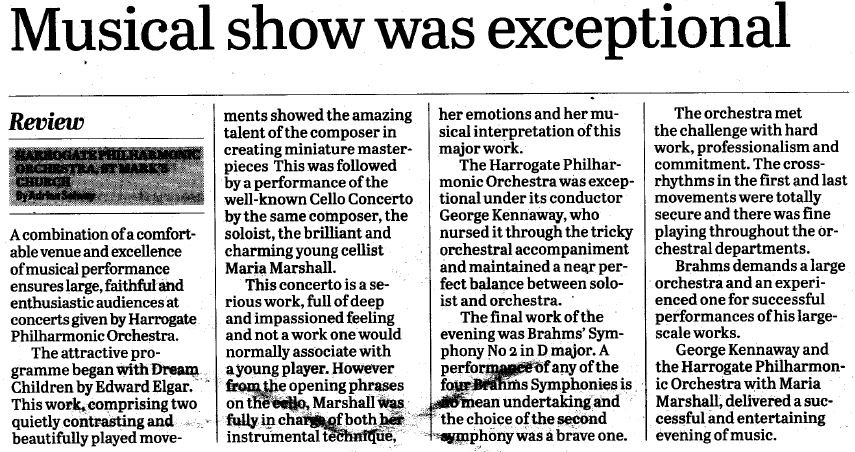
17th October 2015
The Harrogate Philharmonic Orchestra's evening of works by Handel, Boyce, Weber and Mozart provided its large audience with a delightful evening of contrasts, giving the lie to any suggestion that an orchestral concert involving three symphonies would turn out to be worthy but uninviting.
As the encyclopaedic programme notes pointed out, William Boyce's 4th Symphony was originally an overture. The orchestra's strings eased themselves effortlessly into the work's contrasting moods, matched with equal style by crisp and energetic playing from the oboes and horns.
Handel's Concerto Grosso, Op 6, No 6, was, for me, the highlight of the evening: the strings dealt sensitively with extremes of volume, and their pianissimo playing was admirable for its tight ensemble and careful tuning. Leader Rachael Unsworth's elegantly understated rendition of the virtuosic solo violin part was a delight, and the accompaniment was managed with grace and perfect balance.
Weber's Symphony No 2, described by conductor George Kennaway in his introduction as 'one of the oddest symphonies I've ever encountered', featured finely-executed solo passages from the orchestra's woodwind department, as well as fine brass playing. The busy string writing sparkled, though the overall balance was, perhaps a little bass-heavy at times.This evening of three symphonies finished with Mozart's ever-popular 'Jupiter' Symphony, and the orchestra's evident enjoyment of this often difficult work was evident in both the spirited playing and the broad smiles at the end. Throughout, the playing was taut and energetic, and the second movement in particular had a marvellous sense of forward movement as well as a carefully-controlled balance of dark and light.
A thoroughly enjoyable and entertaining evening all in all, and deserving of a very much larger audience. The next concert, on 13th February, featuring Elgar's Cello Concerto, must, on the basis of this evening's performance alone, be worth putting in the diary!
David Barker
14 February 2015 - Harrogate Philharmonic Thrills Valentine's Day Audience
The nave of St Mark's Church was filled almost to capacity to greet Harrogate's Philharmonic Orchestra under its Conductor, George Kennaway for its first concert of 2015.
The Orchestra, admirably led by Eric Clark, presented a most attractive programme of works beginning with the popular Overture to Mozart's opera 'The Magic Flute'. This work was quite a severe test for the Orchestra so early in the overall programme but even so, following the opening chords, the fugato sections were clearly articulated in both major and minor throughout the work with splendid support from both woodwind and brass; some of the woodwind passages being particularly entrancing.
The second work of the evening featured the cello soloist Laura Armstrong in a performance of Kol Nedrei by Max Bruch. This work is based on two Hebrew melodies and in this performance, the audience were treated to some quite exquisite cello playing from the soloist as well as some delightful playing on the harp which also has a prominent part in this work. Miss Armstrong demonstrated her superb artistry as she, at times took a clear solo lead whilst at other times she blended in with the orchestra smoothly emerging again to assume the solo role. George Kennaway coaxed and moulded delightful supporting tones from the Orchestra producing an excellent performance of this unusually attractive work. The final work before the interval was the Suite No 4 by Tchaikovsky entitled 'Mozartiana'. In this rather unusual piece, Tchaikovsky chose a selection of four Mozart works and freely orchestrated them. His arrangement of Mozart's Ave Verum based on Liszt's transcription was beautifully played as was the set of ten variations which formed the final item, the ninth variation containing an amazing extended violin solo brilliantly executed by the Leader of the Harrogate Philharmonic, Eric Clark. Our view of Mozart as a composer has changed radically since the days of Tchaikovsky but nevertheless, this Suite made an attractive addition to the evening.
The second half of the Concert consisted of a performance of the Sixth Symphony by Beethoven, the 'Pastoral' Symphony. This most popular and elegant of the nine Symphonies composed by Beethoven makes huge demands on orchestras and conductors alike. This performance was characterised by the sheer sense of control by the Conductor and the superb concentration and performance of the Orchestra. George Kennaway judged the tempos of the individual movements exceptionally well, especially the second movement showing the true effect of the divisi lower strings. The audience shared the merriment, the coming and passing of the storm, the splendid woodwind section that performed so well all evening and the final prayer of thankfulness bringing this splendid concert to an end.
This concert must rank as one of the finest the Harrogate Philharmonic Orchestra has performed. We must thank the Conductor, Orchestra and Soloist who filled the evening with such lovely music - a delight to the ear. What a splendid way to celebrate Valentine's Day!
Adrian Selway
19 October 2014
The newly refurbished Soothill Hall at Ashville College was the venue for the Autumn Concert given by Harrogate Philharmonic Orchestra under its Conductor George Kennaway, on Sunday 19th October. The Orchestra presented a most attractive programme of works from the Baroque Era through to the work of later Romantic composers opening with the Symphony 83 in G minor 'The Hen' by Haydn. The Orchestra, led by Eric Clark made a bold and very confident start to the stormy nature which pervades much of the first movement. Haydn maintains the dark tonality for much of the movement bursting forth gloriously into the major in the recapitulation; the orchestra seemed to relish this moment, rightfully so! This charming, yet forceful symphony was given a good account and made a good opening to the concert.
The second work played was Bach's Brandenburg Concerto in F major. These fine works of typical Concerto Grosso Form feature groups of soloists within the main orchestra-the group for this being trumpet, Mike O'Farrell, oboes, Pippa Bradbury and Gill Hart, flute, David Barker, Violin, Eric Clark and cello, Fiona Mayo. All played extremely well but special mention must go to Mike O'Farrell who played the trumpet part in the first and third movements, still to this day regarded as one of the most difficult in the repertoire, with brilliance. The lightly scored second movement was one of the highlights of the afternoon with some beautifully phrased playing from all members of the concertino group, the continuo marking the time with beautifully measured tempo. The final movement again featuring amazingly lofty notes on the trumpet was taken at a beautifully measured tempo by George Kennaway. Both concertino and ripieno players performed with great skill throughout what was an excellent performance of this Bach Concerto.The penultimate item in the programme was a performance of The Arrival of the Queen of Sheba by Handel from his oratorio 'Solomon'. This ever-popular work, often heard at weddings, was given a crisp and extremely tidy performance by both strings and woodwind. The interplay of string parts in Handel's writing was obviously being enjoyed by the players; it was lovely to see the slight informality of players really enjoying themselves whilst giving immense pleasure to others.
The final work in this most attractive programme was the Suite 'La Boutique Fantasque' by Rossini, orchestrated from the composer's original piano version by Respighi at the request of Diaghalev to form a ballet suite. Altogether eleven items were played ranging from the elegance of the Valse Lente through the lively and characteristic Tarantella through to the very jolly Can Can. Orchestrally, this is quite tricky music to perform - almost like a jig-saw, all the different components having to fit together perfectly. Harrogate Philharmonic Orchestra, under its Conductor George Kennaway and ably led by Eric Clark gave a good account of its ability to tie most of the ends together bringing to and end what was a very pleasant and entertaining concert.
Adrian Selway
21 June 2014
In spite of the beautiful evening on Saturday, a good and sizeable audience left their gardens and came to St Mark's Church on Leeds Road to hear the Harrogate Philharmonic Orchestra under its Conductor George Kennaway perform its Summer Concert. The Orchestra does have many faithful followers but it was good to see others there as well bringing the audience numbers to nearly seventy.
The programme comprised three works, the first of which was Haydn's Symphony No 92 in G major known as the Oxford Symphony. Haydn's music is always stimulating and very often truly exciting with daring use of tonality and unusual phrase-lengths. The Orchestra, ably led by Eric Clark set about their task with determination and, following the slow introduction took the audience on a thrilling journey through the first movement. The strings took just a little time to settle in their task but ably supported by woodwind and brass, all was soon secured. The glowing warmth of the strings opened the Adagio which also featured beautiful playing from the woodwind and horns especially towards the end of the movement, just before the Coda. The third movement, Minuetto Allegretto is notable for its cross-accented rhythms as demonstrated by George Kennaway at the end of the symphony when he invited a member of the audience to conduct one of the tricky sections; a highlight of the evening!
The second work of the programme was the Sinfonietta Opus 34 by Lennox Berkeley. This interesting work was written in 1950 and gave the opportunity for the Orchestra to show its power of creating tonal colour through the rich tapestry of the composer's score. In the second movement, for example there were some absolutely beautiful flute, oboe and clarinet solos, well supported by horns and bassoon; the strings blending in with great subtlety and care.
After the Interval, The second half of the concert consisted of one work, the Third Symphony by the British composer Sir Hubert Parry. From the outset of this once highly popular work otherwise known as The English Symphony the listener could tell at once its country of origin. The curve of the string phrases and the broad strokes of melodic line eloquently played and skilfully handled by George Kennaway painted a music picture of an England still living in our hearts even if, perhaps, lost on us many years ago. The first movement, carefully crafted was played from the heart but the second movement was, musically, sheer delight in its caressing warmth and sheer beauty of phrasing from all sections of the orchestra but especially the strings who created a superb chorus matched by woodwind and brass. The horn section produced beautiful well-controlled tone not only here but throughout the evening and the long unwinding and climactic last movement brought this magnificent work and the evening to a splendid end.
George Kennaway and Harrogate Philharmonic Orchestra led by Eric Clark worked extremely hard to provide this splendid evening of music and we thank them all for that. Adrian Selway
9 February 2014
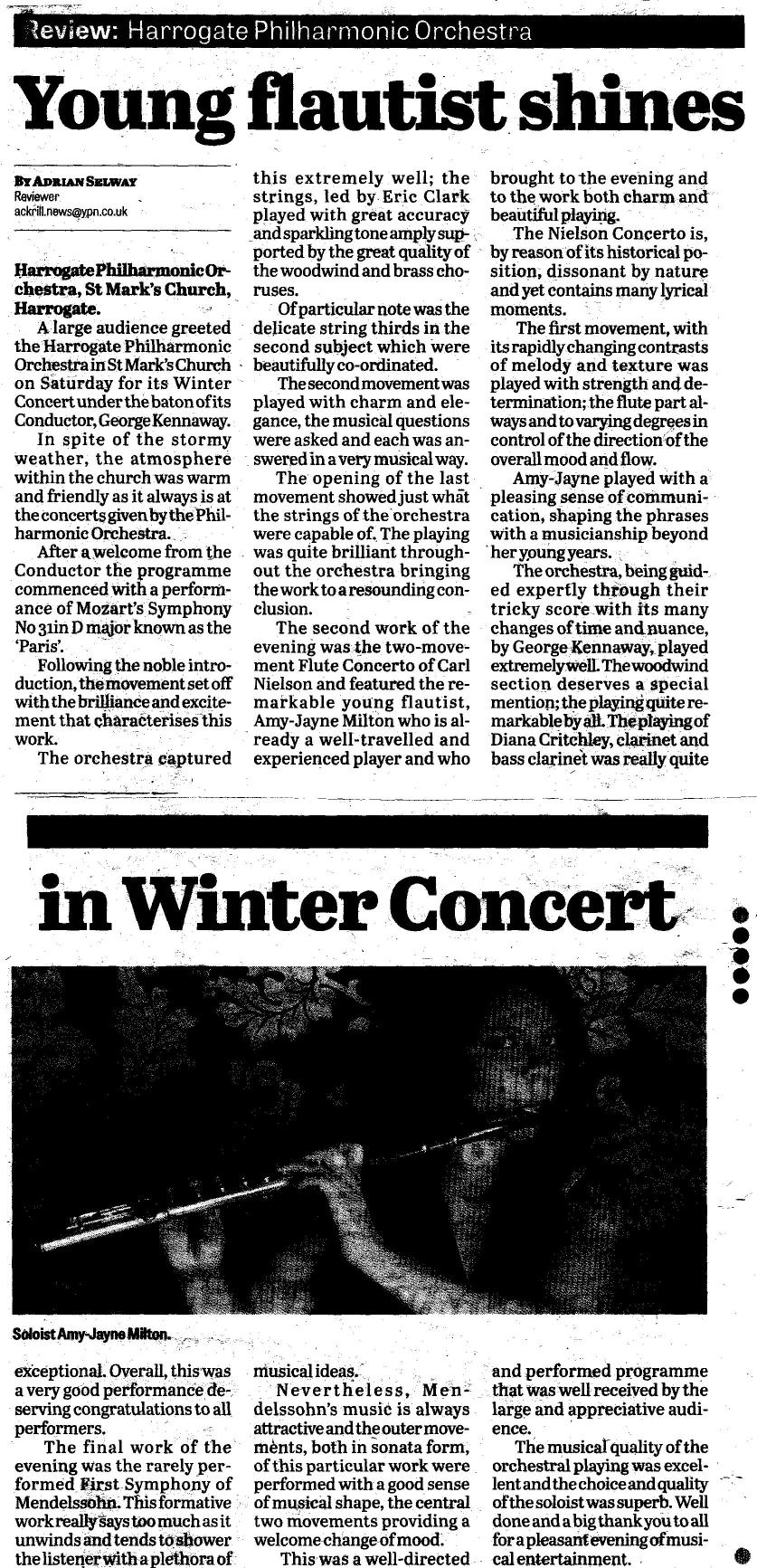
19 October 2013
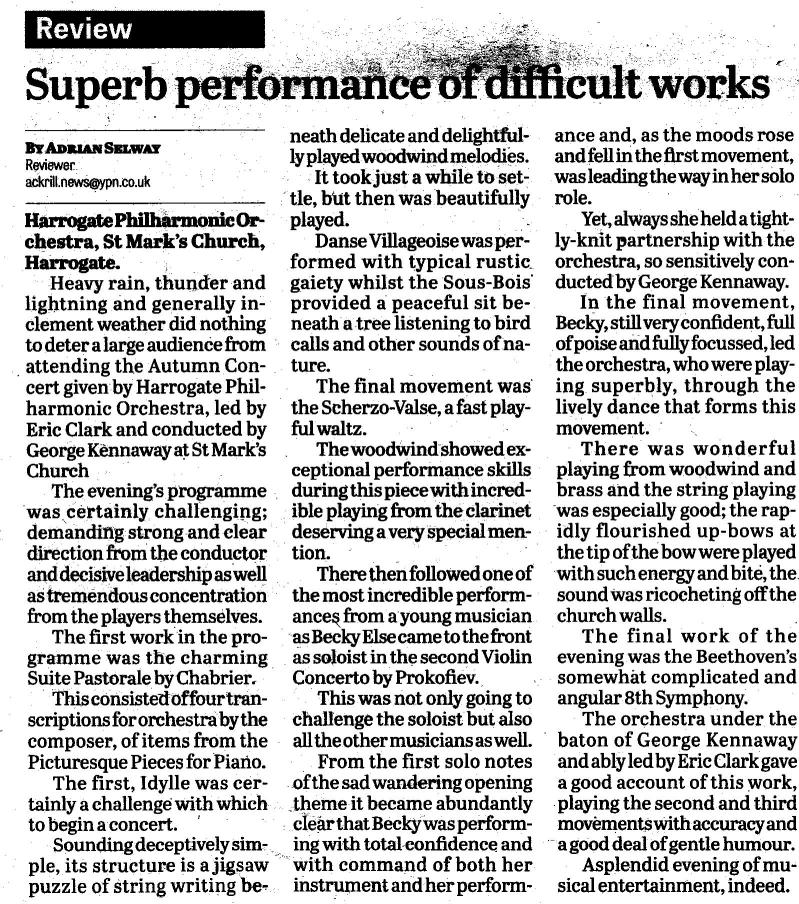
29 June 2013 - two reviews!
Hooray for the Harrogate Philharmonic Orchestra ! Their concert at St. Mark's Church last Saturday evening was brilliant. Amidst an endless ocean of "Pathetiques", "Emperors", "Enigmas". Christmas "Messiahs" and wall-to-wall Max Bruch violin concertos - all fine works, but played to death - the HPO has the intellectual integrity to ignore the "top of the pops" mentality. Instead, conductor George Kennaway and his colleagues provide programs that enable audiences to extend their pleasure in music; and who but a fool would not want to extend their pleasure?. The concert opened with the five delightfully tuneful movements of Dvorak's American Suite, followed by a superb rendering of Saint-Saens richly romantic and powerful Cello Concerto no.1, with the highly talented Oliver Farrant. After the interval came what must have been the Harrogate premier of Charles Ives' Symphony no.3 which, with its interweaving of familiar hymn tunes within complex orchestration is one of the American masters most typical works. An unexpected delight, which - at least for this writer - was a discovery, was Artur Honegger's "Pastorale d'ete", written in about 1920, the gently bucolic atmosphere of which was perfect for a pleasant but cool Harrogate summer's evening. Literate and informative program notes added to the enjoyable orchestral playing, and it only remains for me to thanks the musicians and advise music lovers to keep their eyes skinned for the next performance by the Harrogate Philharmonic Orchestra. Malcolm Neesam.
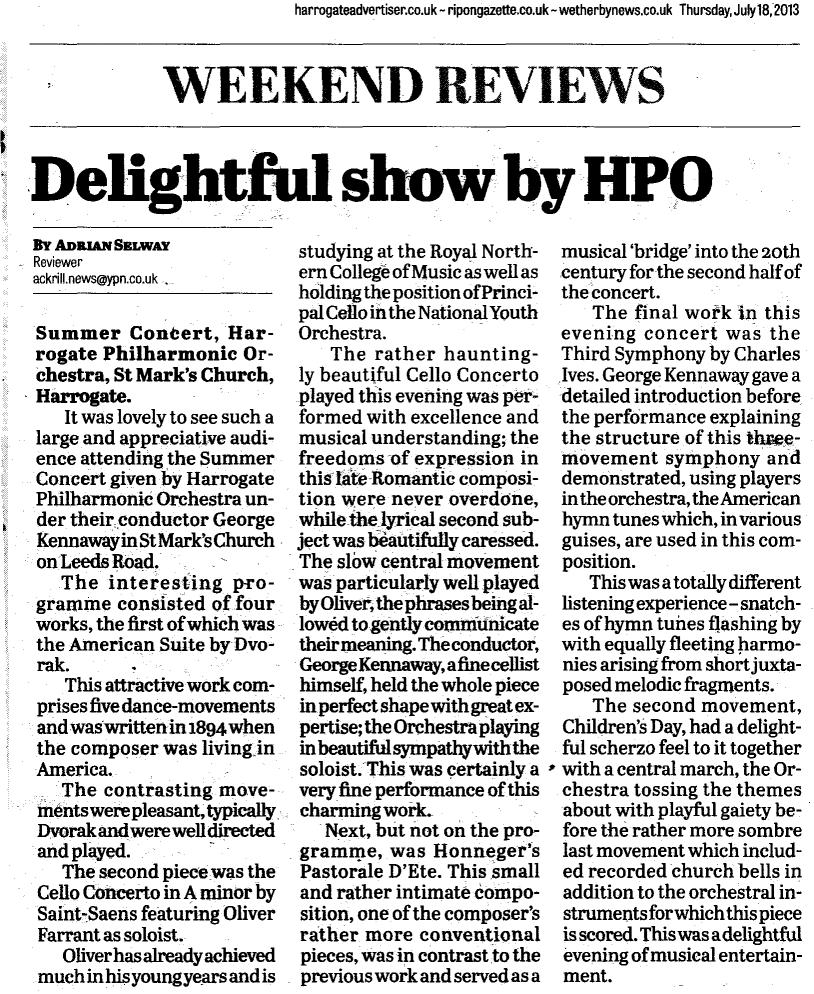
9 February 2013
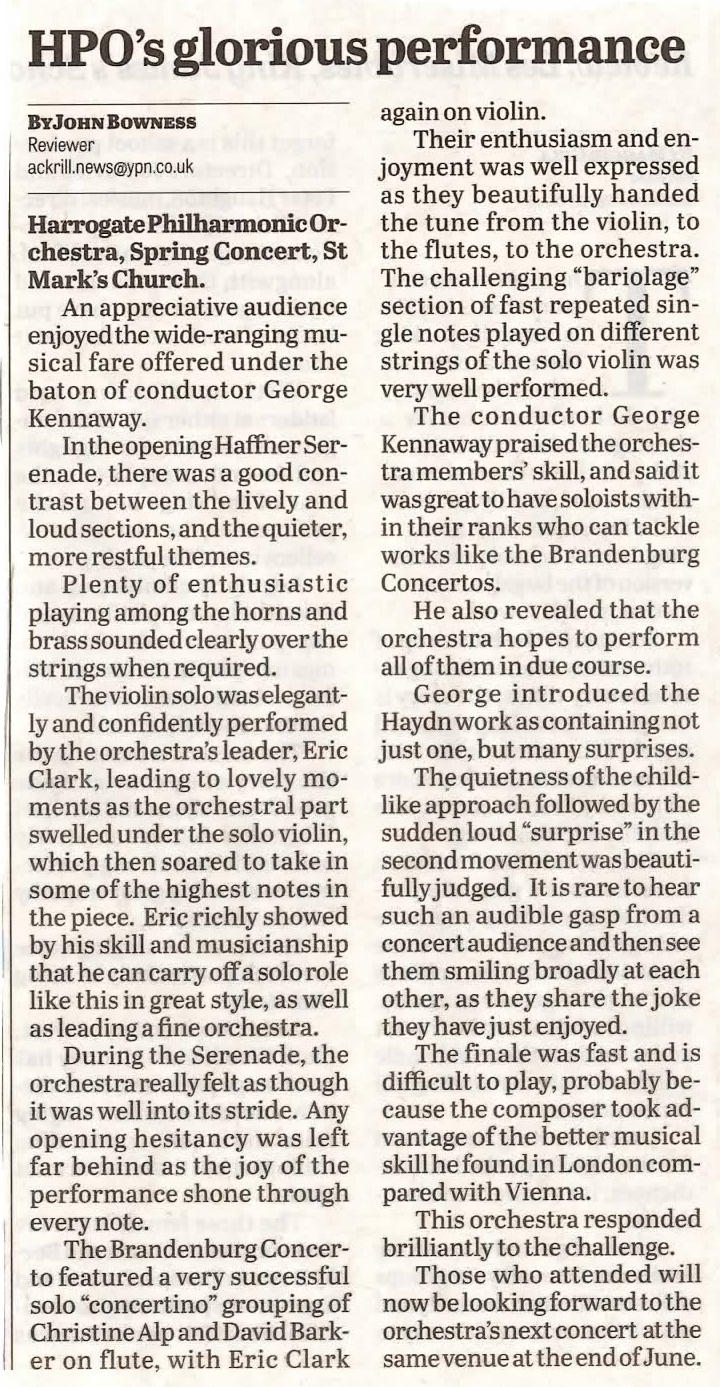
11 February 2012
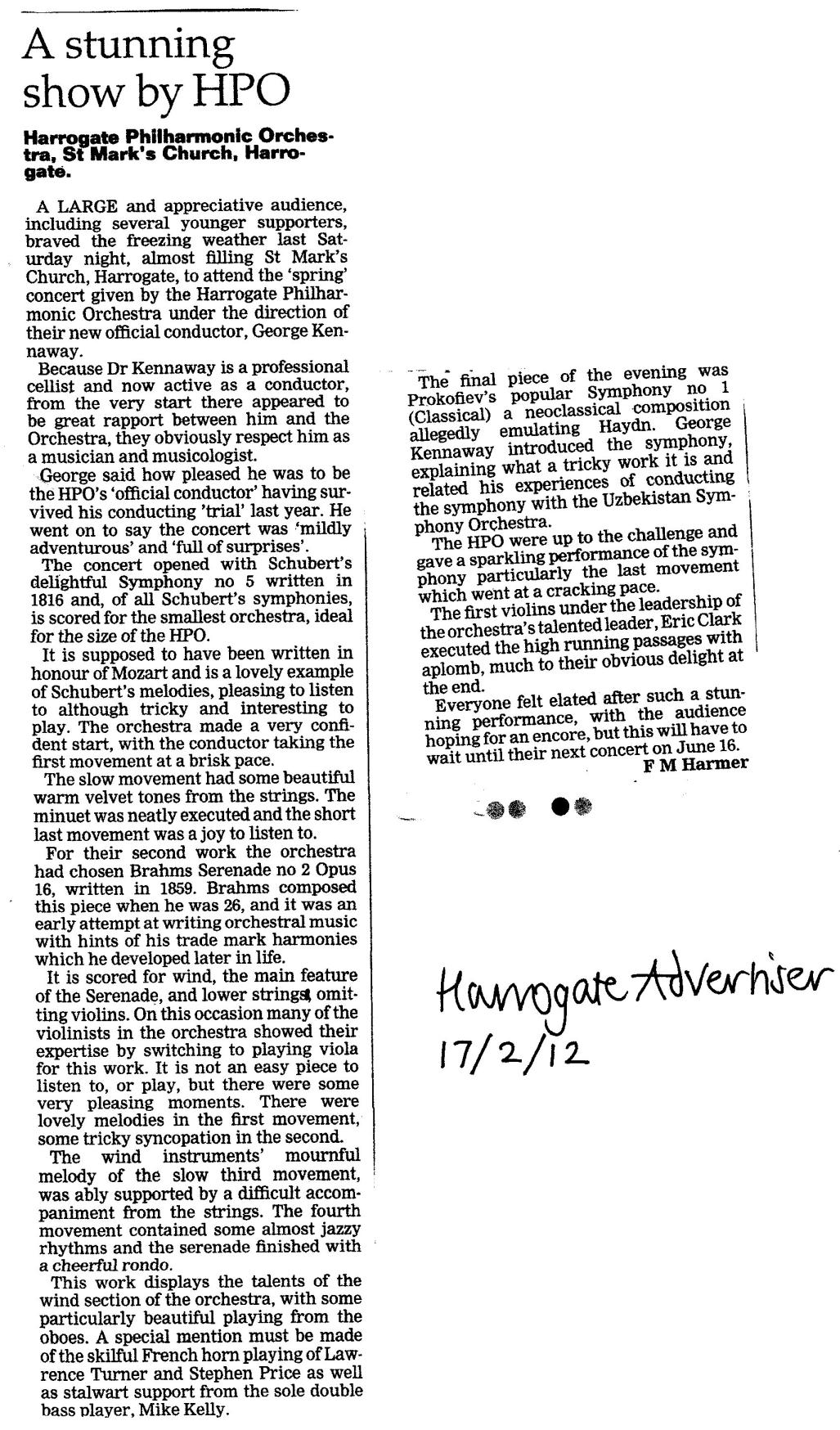
15 October 2011
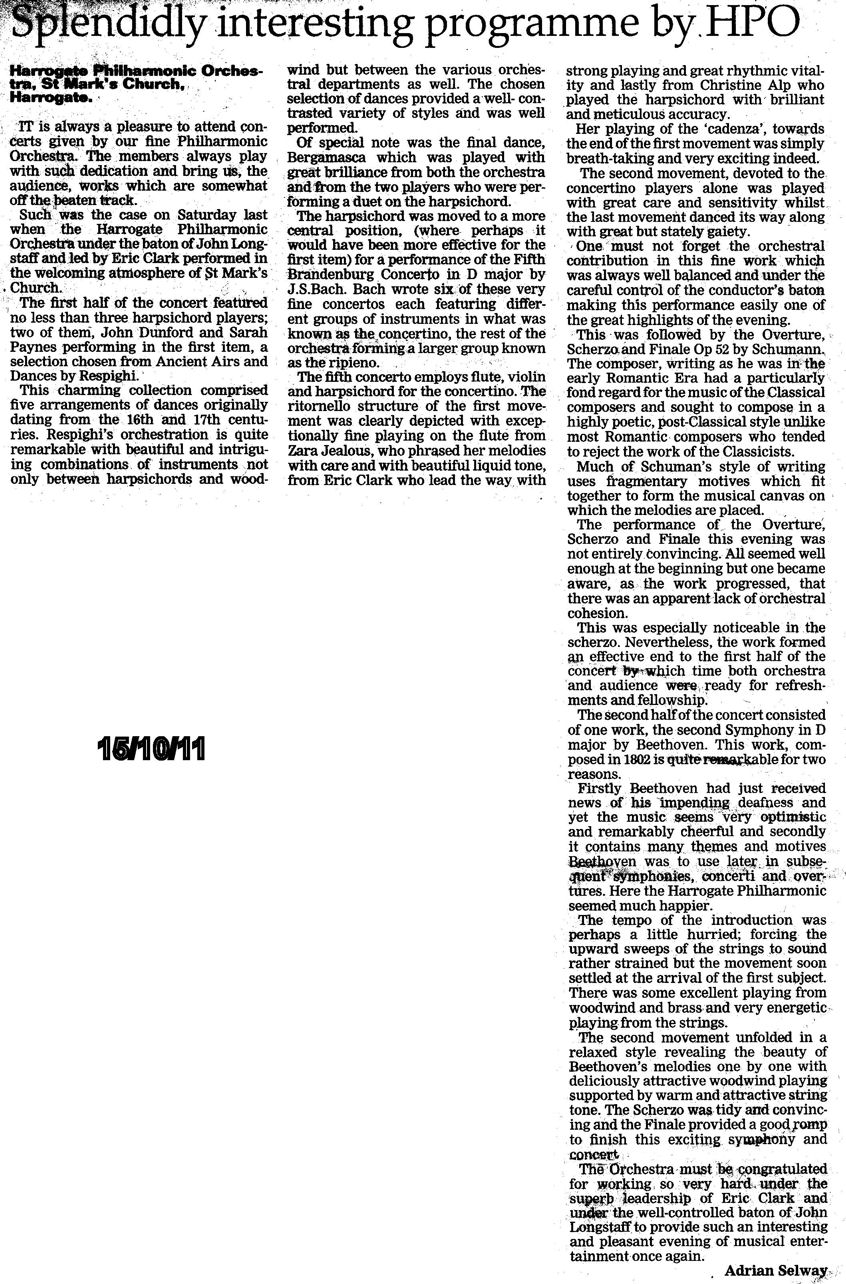
19 June 2011
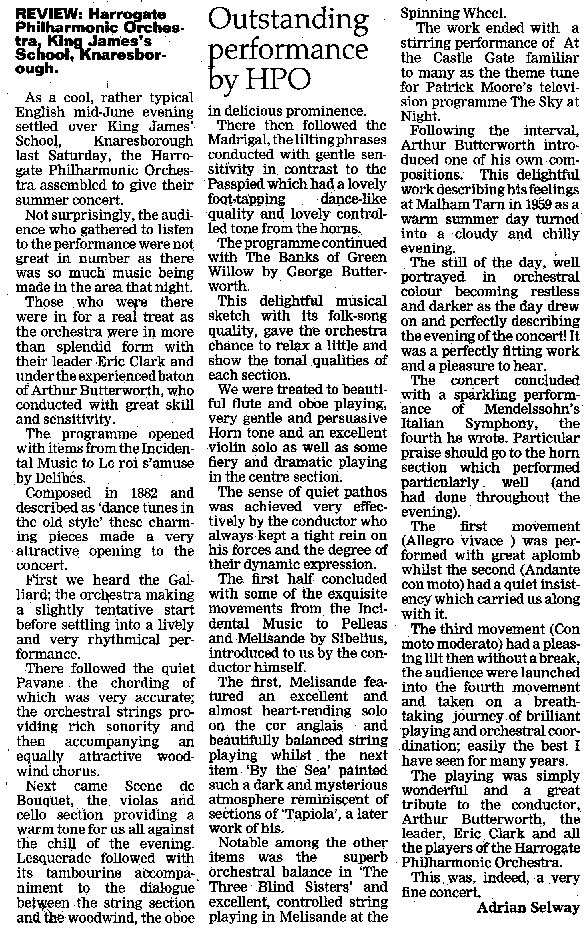
11 February 2011
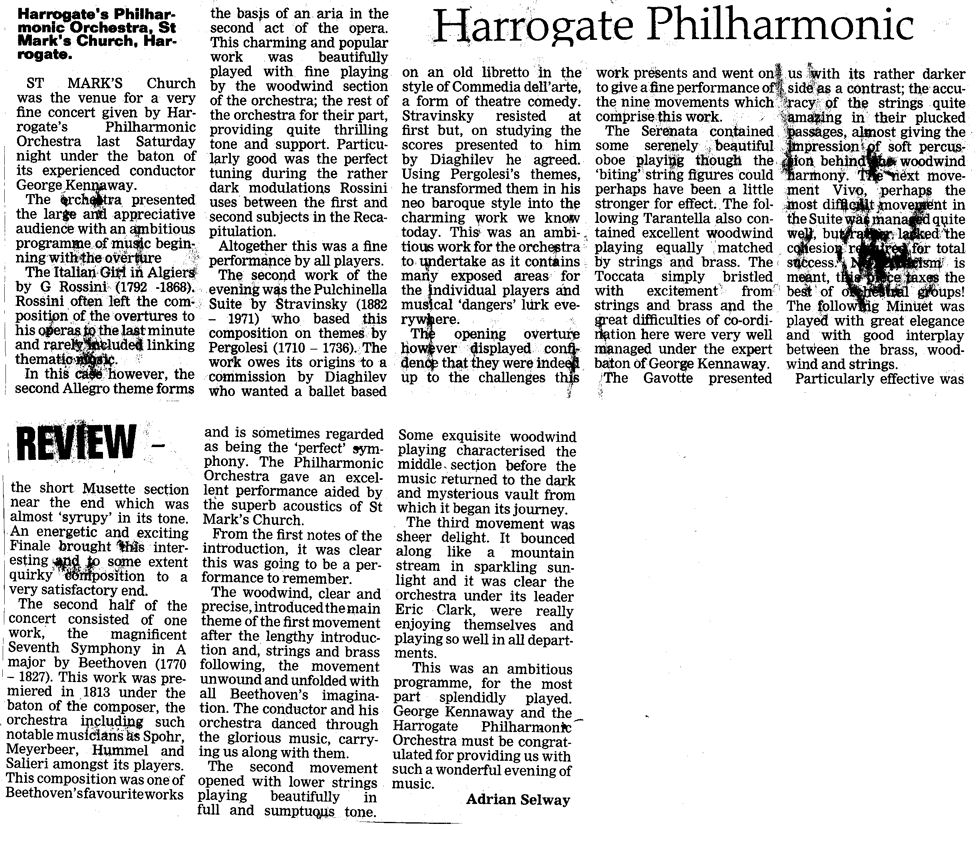
23 July 2010
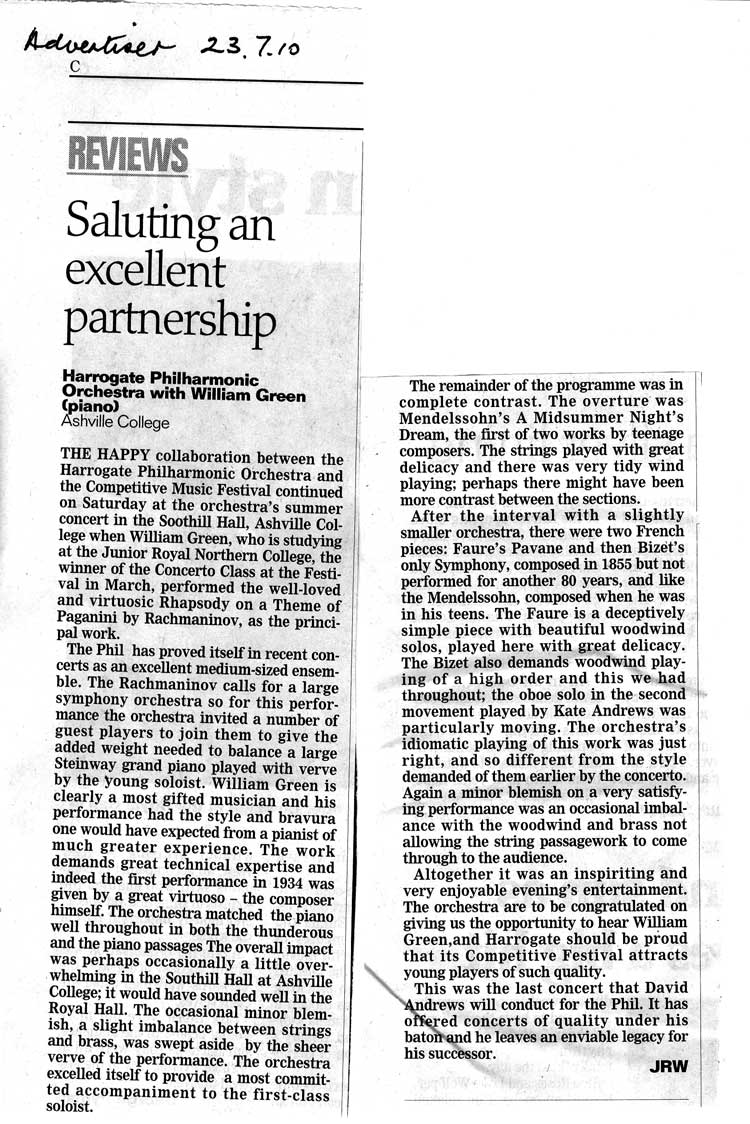
27 February 2010
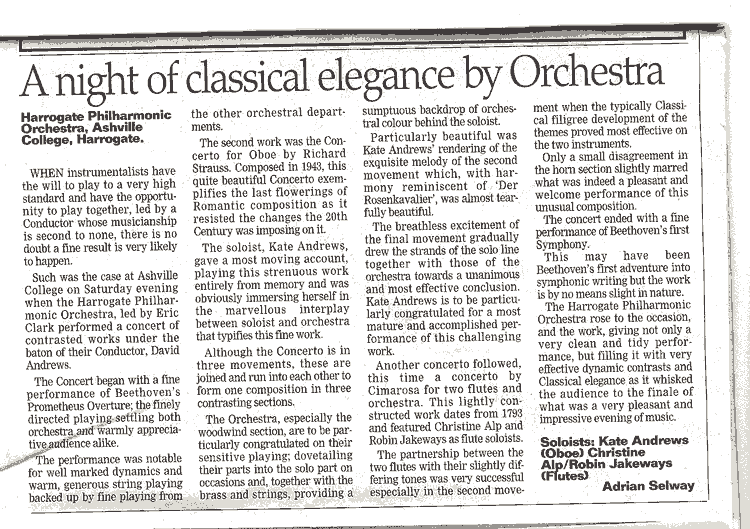
15 November 2009
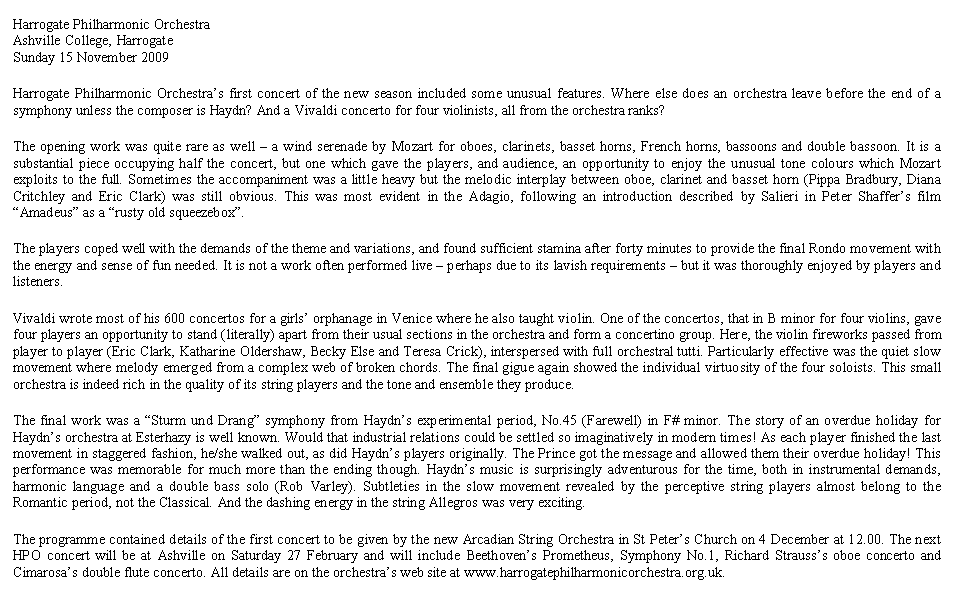
4 July 2009
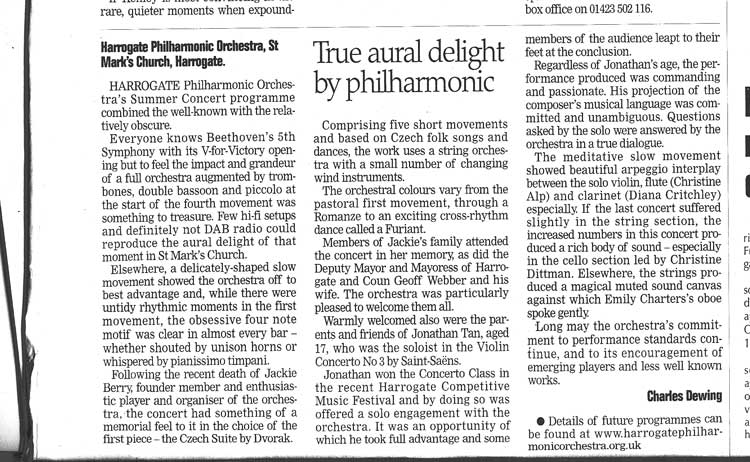
7 February 2009
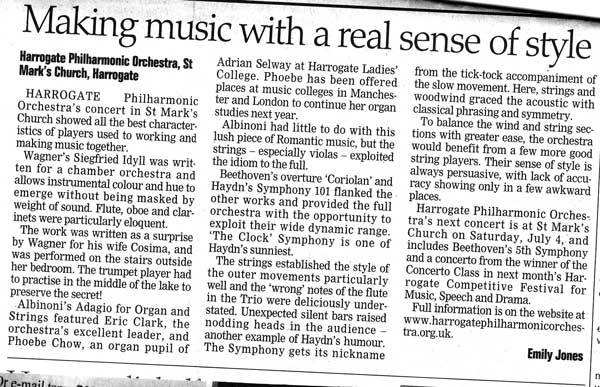
15 November 2008
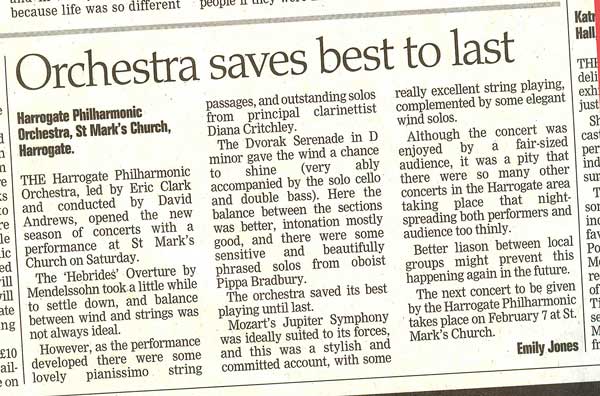
2 February 2008
